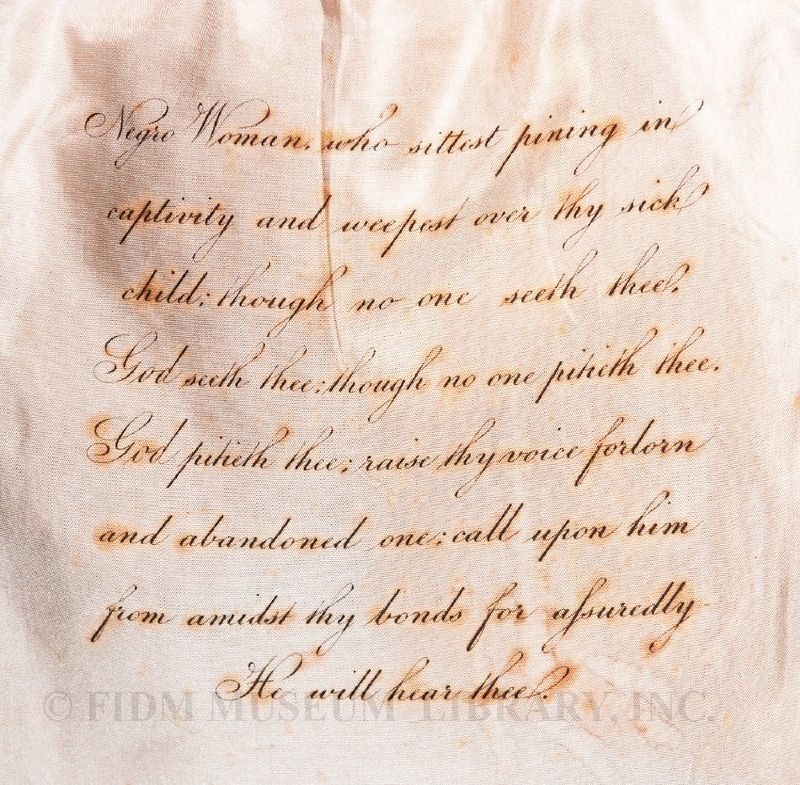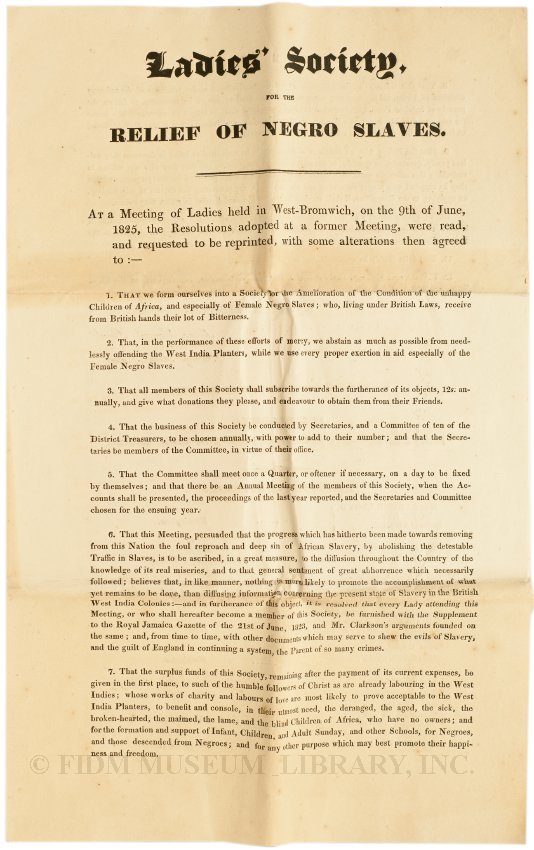It's Fundraising Friday! The FIDM Museum is in the final months of a major fundraising campaign to purchase the Helen Larson Historic Fashion Collection, a private collection of 1,200 historic garments and accessories from four centuries assembled by the late Helen Larson, a collector from Whittier, CA. Each Friday, this blog will feature an exquisite piece from the collection, with information on how you can make a donation to keep these one-of-a-kind treasures together and housed in a public collection in Larson's native Southern California.
Purse
Birmingham, England
c. 1825
Helen Larson Historic Fashion Collection
This week’s post remind us that fashion is not just a matter of taste, but an instrument of profound social change. This silk purse is printed on one side with the image of a slave mother and her baby sitting under a palm tree. On the other side, an inscription describes her “pining in captivity” and urges the “forlorn and abandoned one” to call on God for help. To modern eyes, the sentimental image and words may seem patronizing, but they were intended to capture the sympathy and support of female consumers.
Women became active in the campaign to abolish slavery in Britain in the 1820s, defying traditional gender roles. Hundreds of these reticules were sewn by members of the Ladies’ Society for the Relief of Negro Slaves, later renamed the Female Society for Birmingham, an antislavery organization founded in 1825. The bags–stuffed with abolitionist literature–were distributed to prominent citizens including King George IV, Princess Victoria (the future Queen Victoria), and the wives of aristocrats and politicians.
Detail of Purse
Abolitionist accessories–purses, pincushions, jewelry–became a major fashion trend of the era; related examples can be found in the Victoria & Albert Museum, the Daughters of the American Revolution Museum, and the Library of the Religious Society of Friends. (Quakers were at the forefront of the antislavery movement in both the United Kingdom and the United States). The same image and text can be found on a transfer-printed sugar bowl in the DAR Museum and a matching ceramic plate at Wilberforce House in Hull, the home of English abolitionist leader William Wilberforce.
The Emancipation Act of 1833 abolished slavery in the British territories. But, in the U.S., the fight was just beginning. In 1837, female abolitionists in Boston, New York, and Philadelphia commissioned 100 pieces of silk stamped “from the plate representing a slave mother and her infant sitting under a tree” to make purses of their own.1 This extraordinary survival testifies to the ambition and ingenuity of these female crusaders.
Abolitionist Tract
Ladies' Society for the Relief of Negro Slaves
1825
Helen Larson Historic Fashion Collection
Helen Larson spent 50 years building her collection of historic fashion; now, it is in danger of being dispersed forever or absorbed into another private collection, inaccessible to students, researchers, and the general public. The FIDM Museum needs your help to save the Larson collection. You can make a contribution of any amount online or by mail. Donations are tax deductible; if your company has a matching gift program, your support will go even further. The FIDM Museum has until the end of 2015 to finish raising the necessary funds, so now is the time to join the campaign and help make fashion history.
***********
1 See Alice Taylor, "Fashion has extended her influence to the cause of humanity," pp. 115-142 in Beverly Lemire, ed., The Force of Fashion in Politics and Society (Burlington, VT: Ashgage, 2010), p. 121.




